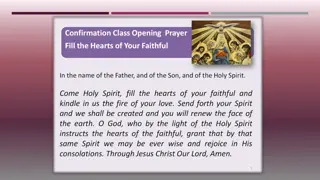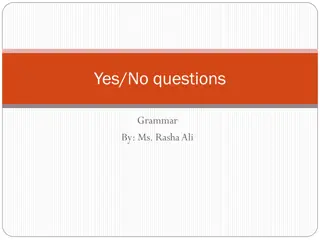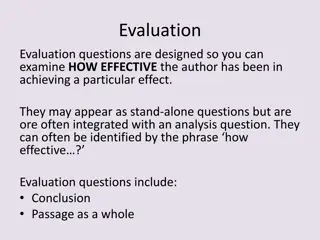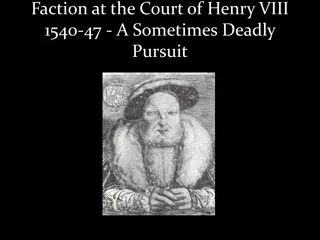
Electrical Circuits: Practical Examples and Calculations
Discover how to analyze resistor networks, calculate total resistance, current, power, and more using MultiSim, Excel, and manual calculations. This comprehensive guide covers series, parallel resistors, capacitors, inductors, RC and RL circuits, providing step-by-step examples and simulations.
Download Presentation

Please find below an Image/Link to download the presentation.
The content on the website is provided AS IS for your information and personal use only. It may not be sold, licensed, or shared on other websites without obtaining consent from the author. If you encounter any issues during the download, it is possible that the publisher has removed the file from their server.
You are allowed to download the files provided on this website for personal or commercial use, subject to the condition that they are used lawfully. All files are the property of their respective owners.
The content on the website is provided AS IS for your information and personal use only. It may not be sold, licensed, or shared on other websites without obtaining consent from the author.
E N D
Presentation Transcript
7 Deadly Questions By: James Zartman
The Questions Using MultiSim, Excel and hand calculations create a set of notes that show how to: 1.) Multiple resistors combine in series and parallel. 2.) By example calculate RT, IT, PT, and all the nodal voltages, branch currents and power dissipation of a resistor network. 3.) By example calculate the Thevenin Resistance and Voltage of a resistor network. 4.) Multiple capacitors combine in series and parallel. 5.) Multiple inductors combine in series and parallel. 6.) Using a simple RC circuit determine the a.) Time Constant (not needed) b.) Create a graph that shows the RC time constant as a function of time (not needed) c.) Determine XC at a fixed frequency d.) Create a graph that shows how XC changes as a function of frequency e.) Plot the frequency response 7.) Using a simple RL circuit determine the a.) Time Constant (not needed) b.) Create a graph that shows the RL time constant as a function of time (not needed) c.) Determine XL at a fixed frequency d.) Create a graph that shows how XL changes as a function of frequency e.) Plot the frequency response
Question #1 Multiple resistors combined in series and parallel There is only one real way to get the total resistance when the resistors of a circuit are all in series. Add them up.. RT= R1 + R2 + R3 + Rn Where n = the number of resistors R1 1k R1= R2= R3= RT= 1.0E+3 330 470 1.8E+3 XMM1 R2 330 RT= R1+R2+R3 R3 470 As you can see the simulation in multisim and the calculation in excel are both in agreement in the that the total resistance is 1.8kohm
Question #1 Multiple resistors combined in series and parallel When working with a circuit with resistors in parallel there are more options in how we solve for the total resistance More than 3 unequal resistors called the reciprocal method (can be used for any # of resistors equal or not) Two unequal value resistors called Product over sum rule Multiple equal value resistors called Equal value branches R1= R2= R3= Rx= n= RT= RT= Multiple equal value resistors 1.0E+3 1.0E+3 1.0E+3 1.0E+3 3.0E+0 333.3E+0 B4/B5 R1= R2= R3= RT= 1.0E+3 2.2E+3 4.7E+3 599.8 R1= R2= RT= RT= 1.0E+3 2.2E+3 687.50 R 1 = RT T= R X R R 1 R 1 R 1 R = RT 1 2 N + + + R R (B1*B2)/(B1+B2) 1 2 1 2 3 Product over sum rule Of 2 unequal resistors Reciprocal method
Question #2 By example calculate RT, IT, PT, and all the nodal voltages, branch currents and power dissipation of a resistor network. To show RT, IT, and PT we will use this simple series parallel circuit with a 9 volt DC power source. RT is solved by first calculating the resistance of R2 and R3 by using product over sum rule. Then take that and add R1 and R4 to the value of R23. Current is found by I=V/R As you can see the values calculated are verified in Multisim. A B C V= R1= R2= R3= R4= R23= 909.1E+0(B3*B4)/(B3+B4) RT= 6.4E+3SUM(B6+B5+B2) IT= 1.4E-3B1/B7 9 1 2 3 4 5 2.2E+3 10.0E+3 1.0E+3 3.3E+3 6 7 8
Question #2 By example calculate RT, IT, PT, and all the nodal voltages, branch currents and power dissipation of a resistor network. The nodal voltage can be calculated by finding the voltage drop by using ?1 = ?? ?1 then take that and subtract that from supplied voltage We find VA to 5.91 volts and VB to be 4.63 Volts Looking at the simulation in Multisim those calculations are verified Total power can be calculated three different ways I P V I P = = 2 V = 2 R P R We find that the total power is equal to 12.6E-3 watts V= R1= R2= R3= R4= R23= RT= IT= PT= PT= PT= V1= VA=V-V1= 5.91E+0B1-B12 VB= 4.63E+0B8*B5 9 A V= R1= R2= R3= R4= B 9 C 2.2E+3 10.0E+3 1.0E+3 3.3E+3 909.1E+0(B3*B4)/(B3+B4) 6.4E+3SUM(B6+B5+B2) 1.4E-3B1/B7 12.6E-3B8*B1 12.6E-3(B8^2)*B7 12.6E-3(B1^2)/B7 3.1E+0B8*B2 1 2 3 4 5 6 R23= 909.1E+0 7 RT= 8 IT= 9 PT= 10 PT= 11 PT= 2.2E+3 10.0E+3 1.0E+3 3.3E+3 (B3*B4)/(B3+B4) SUM(B6+B5+B2) B1/B7 B8*B1 (B8^2)*B7 (B1^2)/B7 6.4E+3 1.4E-3 12.6E-3 12.6E-3 12.6E-3
Question #2 By example calculate RT, IT, PT, and all the nodal voltages, branch currents and power dissipation of a resistor network. Before we can find the power dissipation of each resistor we have to figure out the currents of each branch To do this we use the current divider rule A V= R1= R2= R3= R4= R23= RT= IT= PT= PT= PT= V1= B 9 C 1 2 3 4 5 6 7 8 9 10 11 12 13 VA=V-V1= 5.91E+0 14 VB= 15 I1= 16 I2= 17 I3= 18 I4= ?? 2.2E+3 10.0E+3 1.0E+3 3.3E+3 909.1E+0 6.4E+3 1.4E-3 12.6E-3 12.6E-3 12.6E-3 3.1E+0 ?? = ??+?? ?? As we can see from simulation in Multisim the Calculations match . (B3*B4)/(B3+B4) SUM(B6+B5+B2) B1/B7 B8*B1 (B8^2)*B7 (B1^2)/B7 B8*B2 B1-B12 B8*B5 B1/B7 (B8*B4)/(B3+B4) (B8*B3)/(B3+B4) B1/B7 4.63E+0 1.4E-3 127.7E-6 1.28E-3 1.4E-3
Question #2 By example calculate RT, IT, PT, and all the nodal voltages, branch currents and power dissipation of a resistor network. Now that we know the branch currents we can figure out the power dissipation of the resistor network A V= R1= R2= R3= R4= R23= RT= IT= PT= PT= PT= V1= VA=V-V1= VB= I1= I2= I3= I4= P1= P2= P3= P4= B 9 C 1 2.2E+3 10.0E+3 1.0E+3 3.3E+3 909.1E+0 (B3*B4)/(B3+B4) 6.4E+3 SUM(B6+B5+B2) 1.4E-3 12.6E-3 12.6E-3 12.6E-3 3.1E+0 5.91E+0 4.63E+0 1.4E-3 127.7E-6 (B8*B4)/(B3+B4) 1.28E-3 (B8*B3)/(B3+B4) 1.4E-3 4.3E-3 163.0E-6 1.63E-3 6.5E-3 2 Use Px=Ix2 * Rx 3 4 The calculations match 5 6 the simulation 7 B1/B7 B8*B1 (B8^2)*B7 (B1^2)/B7 B8*B2 B1-B12 B8*B5 B1/B7 8 9 10 11 12 13 14 15 16 17 B1/B7 B15^2*B2 B16^2*B3 B17^2*B4 B18^2*B5 18 19 20 21 22
Question #3 By example calculate the Thevenin Resistance and Voltage of a resistor network. The goal of this theorem is to find an equivalent circuit that isn t as complex This theorem uses two basic steps Step 1 remove the load resistor and determine the voltage that would appear across the load terminals. This will be called VTH in the next slide it is R5 that we remove to be VTH Step 2 short the source then looking back towards the source (battery) determine the total resistance. This will be called RTH this is the circuit on next slide that is in the lower left corner Combine the RTH and VTH together and the resulting circuit is the equivalent Thevenin circuit. On next slide in the lower right corner. You can see on the next slide the step by step process through the circuits going left to right starting at the top. We see that our load resistor was actually R5 in the upper left circuit and we remove that one to continue figuring out the equivalent circuit.
Question #3 By example calculate the Thevenin Resistance and Voltage of a resistor network. A B 100 25 100 25 100 25 501/((1/B3)+(1/B5)) V= R1= R2= R3= R4= RL= R24= 1 2 3 4 5 6 7 RTH= IT= VTH= 251/((1/B7)+(1/(B2+B4))) 4B1/B8 50(B1*B5)/(B1+B5) 8 9 10
Question #4 Multiple capacitors combine in series and parallel. Lets first look at capacitors combined in parallel These sum together like resistors do in series T C C + = 1 + C C 2 n We use this equation to calculate capacitance 1 in multisim ? = ? ? 2?? A B C c1= c2= c3= CT in parallel= 10.0E-6 22.0E-6 47.0E-6 79.0E-6 1 2 3 4 SUM(B1:B3)
Question #4 Multiple capacitors combine in series and parallel. Now lets look at capacitors combined in series These combine together like resistors in parallel 1 = C C C = CT 1 2 T 1 1 1 1 + + + + C C C C C C 1 2 1 2 3 n We use this equation to calculate capacitance 1 2??? ? A B 1 c1= 1.0E-6 2 c2= 2.2E-6 3 c3= 4.7E-6 4 CT in series = 5.998E-61/((1/B1)+(1/B2)+(1/B3)) in multisim ? = C
Question #5 Multiple inductors combine in series and parallel. First lets look at Inductors combined in series These combine together like resistors do in series
Question #5 Multiple inductors combine in series and parallel. Now lets look at inductors in parallel These combine like resistors do in parallel by reciprocal method and product over sum rule
Question #6 Using a simple RC circuit determine Determine Xc at a certain frequency and create a graph that shows how Xc changes as a function of frequency Below we see that a 47uF capacitor at a frequency of 100 hz the Xc is equal to 3.4E+3 Xc for 0.47uf Capacitor A B C C= f 100.0E+0 4.70E-07 Xc 3.4E+31/(2*PI()*(A3)*(B1)) 1 2 3 4.0E+3 3.5E+3 Reactance (ohms) 3.0E+3 2.5E+3 2.0E+3 1.5E+3 1.0E+3 500.0E+0 000.0E+0 100.0E+0 1.0E+3 10.0E+3 100.0E+3 1.0E+6 Frequency (Hz)
Question #6 Using a simple RC circuit determine Plot the frequency response
Question #7 Using a simple RL circuit determine XL at a certain frequency and graph Inductive reactance We see below that XL of 100uH inductor at 1000Hz is 628.3m ohms 700.0E+0 600.0E+0 Create a graph that shows how XL changes as a function of frequency 500.0E+0 400.0E+0 L1= L2= L3= LT= F= 100.0E-6 47.0E-6 22.0E-6 169.0E-6 1.0E+3 XL1= XL2= XL3= XLT= XLT= 628.3E-3 295.3E-3 138.2E-3 300.0E+0 1.06 1.06 200.0E+0 100.0E+0 000.0E+0 100.0E+0 1.0E+3 10.0E+3 100.0E+3 1.0E+6
Question #7 Using a simple RL circuit determine Plot the frequency response






















